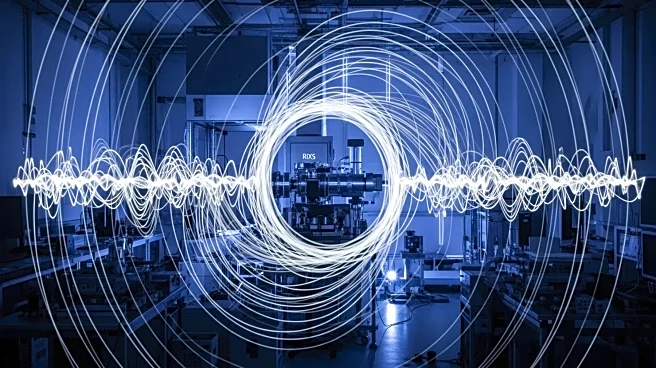What is the story about?
What's Happening?
A recent study published in Nature by Valentina Bisogni and collaborators has made significant advancements in the direct measurement of spin currents. Utilizing resonant inelastic X-ray scattering (RIXS), the researchers have successfully measured a spin current mediated by magnons, providing a quantitative estimate of the magnon lifetime at finite momentum. Traditionally, spin currents have been measured indirectly through electrical transport measurements involving spin-charge interconversion. However, this study marks a breakthrough by employing RIXS, a technique that allows for the measurement of energy and momentum dependence of magnons across various magnetic materials. The research team integrated a spin Seebeck device into their RIXS spectrometer, enabling the measurement of magnons in a YIG single crystal under non-equilibrium conditions with varying temperature gradients.
Why It's Important?
This development is crucial for both fundamental research and practical applications in the field of spintronics. By providing a direct method to measure spin currents, the study enhances the understanding of spin dynamics in magnetic materials, which is essential for the development of future spintronic devices. Spintronics, which exploits the intrinsic spin of electrons and its associated magnetic moment, has the potential to revolutionize data storage and processing technologies. The ability to measure spin currents directly could lead to more efficient and faster electronic devices, impacting industries reliant on data processing and storage. Furthermore, the study's findings could pave the way for new research into high-temperature superconductors and ultra-thin magnetic films, broadening the scope of materials science.
What's Next?
The implications of this study suggest further exploration into the application of RIXS in other magnetic materials and conditions. Researchers may focus on refining the technique to enhance its sensitivity and applicability across a broader range of materials. Additionally, the integration of spin Seebeck devices in RIXS spectrometers could be optimized for more precise measurements. The findings may also prompt collaborations between material scientists and engineers to develop new spintronic devices that leverage the direct measurement of spin currents. As the field progresses, there could be increased interest from the tech industry in adopting these advancements for commercial applications.
Beyond the Headlines
The study highlights the intersection of advanced spectroscopic techniques and material science, emphasizing the importance of interdisciplinary research in driving technological innovation. The ethical considerations of such advancements include ensuring that the development of spintronic devices aligns with sustainable practices and does not exacerbate electronic waste issues. Additionally, the cultural impact of faster and more efficient data processing technologies could influence how society interacts with digital information, potentially reshaping communication and information dissemination.
AI Generated Content
Do you find this article useful?
















